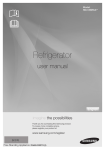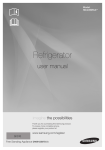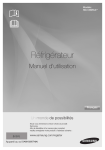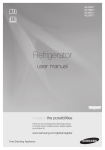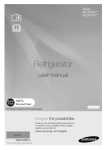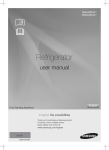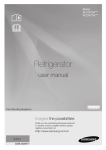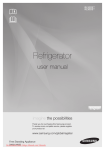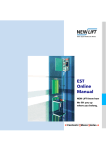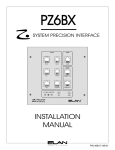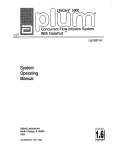Download Samsung RN415BRKASL (/SH) User Manual
Transcript
Model: RN415BRKA** Refrigerator user manual Free Standing Appliance imagine the possibilities Thank you for purchasing this Samsung product. To receive more complete service, please register your product at www.samsung.com/register 条形码 DA68-02507E-3 features of your new refrigerator KEY FEATURES OF YOUR NEW REFRIGERATOR Your Samsung Refrigerator comes equipped with many space-saving, innovative storage and energyefficient features. • Multi compartments and multi temperature zones This refrigerator has 4 compartments: fridge, vegetable & fruit compartment, temperaturevariable compartment and freezer. Fridge, temperature-variable compartment and freezer have separate adjustment of temperature zone which meet different demands of users. • Separate vegetable & fruit compartment The separate vegetable & fruit compartment can keep fruits and vegetables fresh even when they are stored together. • Temperature-variable compartment - Wide range of temperature adjustment Fish and meat can be stored in the Temperature-variable compartment Different storage temperatures can be obtained through adjusting the air door. Different temperatures are set according to types of foods, so as to meet demands of users on different storage temperatures. • Inverter It saves energy and keeps fresh. The refrigeration system is composed of an inverter compressor and an inverter fan, chills every compartment through adjusting and controlling their temperature accurately and realizes optimal operation. • LED touch display It confirms temperature and operation condition of the Refrigerator. • Frost-free refrigerator Your refrigerator is frost-free. Every compartment is equipped with spatial air cool circulation and refrigeration system, so no frost will be formed in compartments and it avoids problem of manual defrosting. • Door alarm A helpful beeper alerts you if a door keeps ajar over 2 minutes. • Tempered glass door (Option) Tempered glass door gives luxurious style. CE Notice This product has been determined to be in compliance with the Low Voltage Directive (2006/95/EC), the Electromagnetic Compatibility Directive (2004/108/EC) and the Eco-Design Directive(2009/125/EC) implemented by Regulation (EC) No 643/2009 of the European Union. For easy future reference, write the model and serial number down. You will find your model number and serial number on the back of the refrigerator. 02_ features Model # Serial # safety information SAFETY INFORMATION WARNING • Before operating the appliance, please read this manual thoroughly and retain it for your reference. • Because these following operating instructions cover various models, the characteristics of your refrigerator may differ slightly from those described in this manual. CAUTION/WARNING SYMBOLS USED WARNING WARNING CAUTION Indicates that a danger of death or serious injury exists. Indicates that a risk of personal injury or material damage exists. OTHER SYMBOLS USED Represents something you must NOT do. Represents something you must NOT disassemble. Represents something you must NOT touch. Represents something you must follow. Indicates that you must disconnect the power plug from the socket. Represents a ground is needed to prevent electric shock. It is recommended that this symbol be handled by service man. These warning signs are here to prevent injury to you and others. Please follow them explicitly. After reading this section, keep it in a safe place for future reference. • This refrigerator must be properly installed and located in accordance with the manual before it is used. • Use this appliance only for its intended purpose as described in this user manual. • We strongly recommend that any servicing be performed by a qualified individual. • R600a can be used as a refrigerant. Check the compressor label or the circuit diagram on the rear of the appliance to see which refrigerant is used for the refrigerator • In case of R600a refrigerant, this gas is natural gas with high environmental compatibility that is, however, also combustible. When transporting and installing the appliance, care should be taken to ensure that no parts of the refrigerating circuit are damaged. • Refrigerant squirting out of the pipes could ignite or cause an eye injury. If a leak is detected, avoid any naked flames or potential sources of ignition and air the room in which the appliance is standing for several minutes. safety information _03 safety information WARNING • In order to avoid the creation of a flammable gas-air mixture if a leak in the refrigerating circuit occurs, the size of the room in which the appliance may be sited depends on the amount of refrigerant used. • The room must be 1m3 in size for every 8g of R600a refrigerant inside the appliance. • Never start up an appliance showing any signs of damage. If in doubt, consult your dealer. • Please dispose of the packaging material for this product in an environmentally friendly manner. • Don’t replace parts of the refrigerator. • keep ventilation openings,in the appliance enclosure or in the built-in structure , clear of obstruction. • Do not use mechanical devices or other means to accelerate the defrosting process ,other than those recommended by the manufacturer. • Do not damage the refrigerant circuit. This warning is only applicable to appliances whis refrigerating circuits which are accessible to the user. • Do not use electrical appliances inside the food storage compartments of the appliance, unless they are of the type recommended by the manufacturer. • Do not store explosive substances such as aerosol cans with a flammable propellant in this appliance. SEVERE WARNING SIGNS • Do not install the refrigerator in a damp place or place where it may come in contact with water. WARNING - Deteriorated insulation of electrical parts may cause an electric shock or fire. • Do not place this refrigerator in direct sunlight or expose to the heat from stoves, room heaters or other appliance.Don’t put burning wax candle or fireworks on the refrigerator. - Otherwise, it will result in hazards of electric shock and fire. • Allow sufficient space to install the refrigerator on a flat surface. - If your refrigerator is not level, the internal cooling system may not work correctly. • Use only 220~240V power. Do not plug several appliances into the same multiple power board. The refrigerator should always be plugged into its own individual electrical which has a voltage rating that matched the rating plate. - This provides the best performance and also prevents overloading house wiring circuits,which could cause a fire hazard from overheated wires. • Never unplug your refrigerator by pulling on the power cord. Always grip plug firmly and pull straight out from the outlet. - Damage to the cord may cause a short-circuit, fire and/or electric shock. • Make sure that the power plug is not squashed or damaged by the back of the refrigerator. • Do not bend the power cord excessively or place heavy articles on it. - This constitutes a fire hazard. • Do not use a loose socket or a cord that shows cracks or abrasion damage along its length or at either end. • If the power cord is damaged, have it replaced immediately by the manufacturer or its service agent. • When moving the refrigerator, be careful not to roll over or damage the power cord. • Do not insert the power plug with wet hands. • Remove any foreign matter or dust from the power plug pins. - Otherwise there is a risk of fire. • If the refrigerator is disconnected from the power supply, you should wait for at least ten minutes before plugging it back. • If the wall socket is loose, do not insert the power plug. - There is a risk of electric shock or fire. • The appliance must be positioned so that the plug is accessible after installation. • Do use separate and reliable earthing power. Don’t share a socket with other appliances. In order to ensure safety, the socket and its connecting wire must be able to bear over 10A current. 04_ safety information • • • • • • • • • • • • • • The refrigerator must be grounded. - You must ground the refrigerator to prevent any power leakages or electric shocks caused by current leakage from the refrigerator. • Never use gas pipes, telephone lines or other potential lightening rods as ground. - Improper use of the ground plug can result in electric shock. • Do not dissemble or repair the refrigerator by yourself. - You run risk of causing a fire, malfunction and/or personal injury. If you smell pharmaceutical or smoke, pull out power plug immediately and contact your Samsung electronics service center. Keep ventilation opening in the appliance enclosure or mounting structure clear of obstruction. Do not use mechanical devices or any other means to accelerate the defrosting process, other than those recommended by the manufacturer. Don’t dismantle, repair or adapt structure of the refrigerator unadvisedly; otherwise, its refrigeration system may be damaged. Do not damage the refrigerant circuit. Do not place or use electrical appliance inside the refrigerator/freezer, unless they are of a type recommended by the manufacturer. Don’t put a dryer in the refrigerator for drying. Do not replace LED lamp privately and please contact the specialized repair staff if necessary. The appliance is not intended for use by persons (including children) with reduced physical,sensory or mental capabilities, or lack of experience and knowledge, unless they have been given supervision or instruction concerning use of the appliance by a person responsible for their safety. Children should be supervised to ensure that they do not play with the appliance. Do not let children hang on the door. If not, a serious injury may occur. Do not touch the inside walls of the freezer or products stored in the freezer with wet hands. - This may cause frostbite. If the refrigerator is not to be used for a long period of time, pull out the power plug. - Deterioration in the insulation may cause fire. Do not store articles on the top of the appliance. - When you open or close the door, the articles may fall and cause personal injury and/or material damage. CAUTION SIGNS • Before the refrigerator is put into use, its leveling legs must be adjusted to contact the CAUTION ground, and the refrigerator must be leveled, so as to avoid tilting. • This product is intended only for the storage of food in a domestic environment. • Manufacturer’s recommended storage times should be adhered to. Refer to relevant instructions. • Bottle should be stored tightly together so that they do not fall out. • Don’t store any carbonated drink or soda water in the freezer. • Do not overfill the refrigerator with food. - When you open the door, an item may fall out and cause personal injury or material damage. • Do not put bottles or glass containers in the freezer. - When the contents freeze, the glass may break and cause personal injury. • Do not spray inflammable gas near the refrigerator. - There is a risk of explosion or fire. • Do not directly spray water inside or outside the refrigerator or wipe it with benzene or alcohol. - There is a risk of fire or electric shock. • the instructions for ice-markers not intented to be connected to the water supply shall state the substance of the following warning: - fill with potable water only. safety information _05 safety information • Do not store volatile or flammable substances in the refrigerator. -Thestorageofbenzene,thinner,alcohol,ether,LPgasandothersuchproductsmay cause explosions. • You are recommended to empty the refrigerator and turn it off when you have a long term journey. • Do not re-freeze frozen foods that have thawed completely. • Do not store pharmaceuticals products, scientific materials or temperature-sensitive products in the refrigerator. -Productsthatrequirestricttemperaturecontrolsmustnotbestoredintherefrigerator. • Do not put a container filled with water on the refrigerator. - If spilled, there is a risk of fire or electric shock. • The two legs in the front of the refrigerator are rotatable. The front legs contact the ground so that the refrigerator will not move when opening its doors. • Do not apply strong shock or excessive force onto the surface of glass. - Broken glass may result in a personal injury and/or property damage. CAUTIONSIGNSFORCLEANING • Do not insert your hands into the bottom area under the appliance. - Any sharp edges may cause personal injury. • Don’t use wet cloth to clean the plug or remove its foreign substances or dust. - Otherwise, it will result in fire hazard. WARNINGSIGNSFORDISPOSAL • Whendisposingofthisorotherrefrigerator/s,removethedoor/doorseals,doorlatchso that small children or animals cannot become trapped inside. • Leave the shelves in place so that children may not easily climb inside. R600a is used as a refrigerant. Check the cimpressor label or the rating label on the rear oftheappliancetoseewhichrefrigerantisusedforyourrefrigerator.Whenthisproduct contains flammable gas(Refrigerant R600a)contact your local authority in regard to safe disposal of this product. • Cyclopentane is used as a insulation blowing gas. The gases in insulation material requirespecialdisposalprocedure.Pleasecontactyourlocalauthoritiesinregardtothe environmentally safe disposal of this product. Ensure that none of the pipes on the back of the appliances are damaged prior to disposal. The pipes shall be broke in the open space. In the event of a power failure, call the local office of your Electricity Company and ask how CAUTION long it is going to last. Most power failures that are corrected in an hour or two will not affect your refrigerator temperatures. However, you should minimize the number of door openings while the power is off. But should the power failure last more than 24hours, remove all frozen food; you’d better rise temperature of the freezer to at least 0°C and remove all ice blocks in the ice bunker; otherwise, it will result in flowing water or damage of the mechanism. There is protective film on the surface of some refrigerator models, which is used to CAUTION protect the refrigerator from scratches during transport. To avoid static electricity, please peel off the protective film slowly. If the protective film is not removed for a long time, it may cause color shading of the steel plate. 06_ safety information safety information ADDITIONAL TIPS FOR PROPER USAGE • Allow the appliance to stand for 2hours after installation. • To get best performance of product, - Do not place foods too closely in front of the vents at the rear of the appliance as it can obstruct free air circulation in the freezer compartment. - Wrap the food up properly or place it in airtight containers before put it into the fridge freezer - Do not put any newly introduced food for freezing near to already frozen food. • Do not place carbonated or izzy drinks in the freezer compartment. • Please observe maximum storage times and expiry dates of frozen goods. • There is no need to disconnect the refrigerator from the power supply if you will be away for less than three weeks. But, remove all the food if you are going away for the three weeks or more. Unplug the refrigerator and clean it, rinse and dry. • Most power failures that are corrected in an hour or two will not affect your refrigerator temperatures. However, you should minimize the number of door openings while the power is off. But should the power failure last more than 24hours, remove all frozen food. • Do not store food which goes bad easily at low temperature, such as bananas, melons. • Place the ice tray at the originally provided posistion by manufacturer in order to achieve optimal ice-freezing. • Your refrigerator is frost-free, so you are no need to defrost manually and the refrigerator will do so automatically. • Temperature rising during the defrost can comply with ISO requirement. But If you want to prevent an undue rise in the temperature of the frozen food while defrosting the appliance, please wrap the frozen food in several layers of paper such as newspaper. • Any increase in temperature of frozen food during defrosting can shorten its storage life. • This appliance is intended to be used in household and similar applications such as – staff kitchen areas in shops, offices and other working environments; – farm houses and by clients in hotels, motels and other residential type environments; – bed and breakfast type environments; – catering and similar non-retail applications. Saving Energy Tips • Install the appliance in a cool, dry room with adequate ventilation. Ensure that it is not exposed to direct sunlight and never put it near a direct source of heat (radiator, for example). • Never block any vents or grilles on the appliance. • Allow warm food to cool down before placing it in the appliance. • Put frozen food in the refrigerator to thaw. You can then use the low temperatures of the frozen products to cool food in the refrigerator. • Do not keep the door of the appliance open for too long when putting food in or taking food out. The shorter time for which the door is open, the less ice will form in the freezer. • Clean the rear of the refrigerator regularly. Dust increases energy consumption. • Do not set temperature colder than necessary. • Ensure sufficient air exhaust at the refrigerator base and at the back wall of the refrigerator. Do not cover air vent openings. • Allow clearance to the right, left, back and top when installing. This will help reduce power consumption and keep your energy bills lower. safety information _07 contents SETTING UP YOUR REFRIGERATOR 09 Installing the refrigerator OPERATING YOUR REFRIGERATOR 11Introduction, operation skills and storage notices of refrigerator parts 18 Functions and operation of display panel 20 Disassembly and clean the parts 09 11 GENERAL INFORMATION 22 TROUBLESHOOTING 23 INFORMATION CODE 24 APPENDIX 25 08_ contents setting up your refrigerator INSTALLING THE REFRIGERATOR 1.Selecting the best location for the refrigerator *The following table lists heights and depths of different models of Samsung refrigerators. Width Dimension (mm) RN415BRKASN RN415BRKASL 720 mm 720 mm Fridge door is opened 1145 mm 1126 mm Door is closed 699 mm 694 mm Fridge door is opened (max. size) 993 mm 994 mm 1114 mm 1110 mm 1098 mm 1094 mm 1875 mm 1875 mm Model Door is closed Depth Door of Vegetable & fruit compartment is opened Doors of temperature-variable compartment and freezer are opened Height With door If the clearance between the Refrigerator and surrounding furniture and wall is too small, it will restrain heat dissipation capability, reduce refrigerating capacity and increase power consumption. • Install the Refrigerator at a dry and well-ventilated location Install the Refrigerator at a well-ventilated location. Don’t install it at a damp or easily damped location so as to prevent metal parts from rusting or being shocked. • Avoid heat and direct sunlight If the environmental temperature is too high, the refrigerating capacity may reduce and power consumption may increase. If it is installed at a place full of gas or fog, its surface may discolor. 2.Leveling the Refrigerator • Put it at a firm and level place. If the place is uneven, it can be leveled by adjusting the leveling legs at its lower part (rotate anticlockwise to rise). Note: Open the draws of the freezer while you adjuste the leveling legs. Raise Lower setting up _09 01 SETTING UP A proper distance is kept between the Refrigerator and its surroundings. Allow clearance to the top, back, left and right when installing. This will help to reduce power consumption and saving energy. To keep smooth circulation of air around the Refrigerator, please leave the Refrigerator 55mm from wall of both sides and rear side and 300mm from top wall. setting up your refrigerator INSTALLING THE REFRIGERATOR • When it is installed on carpet or floor, put a firm backing board on it to prevent the ground from discoloring when heated. Don’t use the bearing plate provided by us for delivery directly as a backing board. If it is installed at an uneven place, it will lead to shake and noise and shorten its service life. • Adjust front of the Refrigerator to keep it a little bit higher than the rear part. Shake the Refrigerator from front to back, left and right and across corners to check if it is firm; adjust leveling legs of the front part again to keep it a little bit higher than the rear. If the front is lower, the Refrigerator doors may not be closed, its performance may be badly affected, and some frost may be formed. 3.Adjust parallelism If doors descend after the Refrigerator is installed and stored with foods, please adjust parallelism of doors according to drawings 4~5 days after installation. 4. Clean, install accessories and connect power Remove the dust accumulated on the Refrigerator while transporting. Refer to the following instruction of the manual for installation of relevant accessories. To prevent damage during transporting, some accessories are packed together. Insert power plug to 220V socket. Don’t share a socket with other equipment. 10_ setting up operating your refrigerator INTRODUCTION, OPERATION SKILLS AND STORAGE NOTICES OF REFRIGERATOR PARTS 02 OPERATING Fridge Vegetable & fruit compartment Temperaturevariable compartment Freezer Notice on foods storage: The fridge is for storing fresh foods, and its good storage mode is essential for keeping foods fresh and delicious. Don’t store the foods which are easy to go bad at low temperature, i.e. banana, complete tropical fruit etc. Super cool will lead to discoloring of those foods and reduce their vitamin. Don’t store hot foods until they are cool; or it will rise temperature of the Refrigerator, affect freshness of other foods and waste power. Don’t open doors frequently; or hot gas will enter the Refrigerator and its temperature will rise. Don’t put too much food on the bottle holder; or it may be unable to close doors. Seal vessels with preservative film or plastic bag or store foods with covered vessels, so as to prevent water from vaporizing, keep flavor and nutrition of foods and reduce odor within the Refrigerator. The air outlet can’t be blocked by foods; otherwise cooling speed of foods will be slow down. operating _11 operating your refrigerator NAMES, OPERATION SKILLS AND STORAGE NOTICES OF FRIDGE PARTS Names of fridge parts Store foods in the fridge To get the best energy efficiency of this product, please leave all selves, drawers and baskets on their original position like as above illustration. ( 1 ) Dressing case(option) Put cosmetics or some expensive and small items. (RN415BRKASN , RN415BRKASL use small bottle holder) ( 2 ) Small bottle holder Store foods with small packages. ( 3 ) Movable Center Pillar Ensure tightness of the fridge ( 4 ) Fresh food compartment Store vegetable and fruit. This drawer is airproof. The foods stored here will not affect those in the fridge, so it keeps original taste of the foods in the fridge ( 5 ) Upper glass shelf Store various foods and drinks. ( 6 ) Foldable shelf Store various foods and drinks. After it is folded, the lower glass shelf can store higher foods and drinks. 12_ operating Store various foods and drinks. ( 8 ) Egg tray Store eggs and other small foods. ( 9 ) Small drawer Store vegetable and fruit. 02 OPERATING ( 7 ) Lower glass shelf ( 10 ) Big bottle holder Store big foods, i.e. big bottles and vessels etc. OPERATION SKILLS OF FRIDGE PARTS 1. In order to store more and higher foods and drinks, the foldable shelf can be adjusted (refer to disassembly and cleaning section of the foldable shelf for adjusting method). A bigger space can be obtained by rotating the foldable shelf. 2. Lift front of the front shelf and pull it to fall the glass, or push it; the whole shelf can be turned over when it is pulled out to full extension; then higher foods and drinks can be stored on the lower glass shelf. 3. Adjust height of the small bottle holder: there are high and low loose cores on the inner layer for storing small bottle holder. It can be adjusted according to demands of users to meet requirements of storage. High and low loose core 4. If the bottles on the big bottle holder collide with those on the small bottle holder, the small bottle holder can be adjusted to higher loose core or removed directly. operating _13 operating your refrigerator OPERATION SKILLS OF FRIDGE PARTS 5. When the movable center pillar is turned over, the door can’t be closed properly. In such case, the movable center pillar should be placed to its original position. When the movable center pillar is at the above state, the door can’t be closed properly. When the movable center pillar is at the above state, the door can be closed properly. Note: In order to prevent frost, the movable center pillar is equipped with a heater. It’s normal if the movable center pillar gives out heat and it will not affect the stored foods. 6. Two sections design of the bottom big bottle holder: you can put foods according to demands. You are recommended to put bottles less than 1.5L at rear side of the big bottle holder. In order to close doors properly and keep low power consumption, you’d better not store foods higher than the bottle holder at front side. 7. In order to prevent the right door from being bounced off, you’d better close left door and right door in order. NOTICES ON STORAGE OF THE FRIDGE 1. Don’t put damp foods on the upper shelf; or they may be frozen when contacting cold air. 2. Before being stored in the Refrigerator, foods, vegetables, fruits and their packages should be cleaned and wiped, so as to avoid affecting adjacent foods. 3. In order to prevent bottles from falling while opening doors, they should be put together tightly. 4. Air vents of the fridge are at both sides of its inside, so foods can’t be stored at both sides near back of the fridge. 14_ operating NAMES, OPERATION SKILLS AND STORAGE NOTICES OF VEGETABLE & FRUIT COMPARTMENT PARTS Names of vegetable & fruit compartment parts OPERATION SKILLS AND STORAGE NOTICES OF THE VEGETABLE & FRUIT COMPARTMENT PARTS 1. There are upper and lower drawers in the vegetable & fruit compartment. Fruits and vegetables can be stored separately here. 2. Position of the moveable drawer within the vegetable & fruit compartment can be adjusted according to sizes of foods. 3. The foods to be stored here can’t exceed certain height; otherwise the moveable drawer can’t be put in place or be closed properly. 4. Vegetables and fruits should be put in drawers of the vegetable & fruit compartment. Don’t put them outside the drawer. Note: Temperature of the vegetable & fruit compartment is uncontrollable and is adjusted automatically according to temperature change of the fridge. operating _15 02 OPERATING Big drawer of vegetable & fruit compartment Movable drawer of vegetable & fruit compartment operating your refrigerator NAMES, OPERATION SKILLS AND STORAGE NOTICES OF TEMPERATURE-VARIABLE COMPARTMENT PARTS Names of temperature-variable compartment parts Splitter plate of temperaturevariable compartment Drawer of temperaturevariable compartment OPERATION SKILLS OF TEMPERATURE-VARIABLE COMPARTMENT PARTS 1. Its drawer can only store foods not exceeding certain height; otherwise it may be unable to be closed properly. 2. Its splitter plate can store different foods in sorts, and two positions are available according to demands. If foods are bulky, the splitter plate can be dismantled. STORAGE NOTICES OF TEMPERATURE-VARIABLE COMPARTMENT 1. Don’t put bottles in temperature-variable compartment; or the substances in bottles will freeze and bottles may break. 2. Don’t put the unfrozen foods in temperature-variable compartment again; or it will result in loss of flavor and nutrition. 3. Don’t touch foods or vessels (particularly metal vessels) with wet hands; or hands will frostbite. 4. Don’t put foods outside the drawer of temperature-variable compartment. 5. Setting range of the temperature of temperature-variable compartment is -7°C~-18 °C. When it is set to -7°C, fish and meat can be stored at soft freezing state for a short time. If you touch foods or vessels with wet hands directly, your hands may frostbite, or you WARNING may be injured due to crack of vessels. Please operate with care. 16_ operating NAMES, OPERATION SKILLS AND STORAGE NOTICES OF FREEZER PARTS Names of freezer parts Lower drawer of freezer Steel support OPERATION SKILLS OF FREEZER PARTS 1. Its upper drawer is for storing small package foods to be frozen. 2. Its lower drawer is for storing big package foods to be frozen. The steel support in the lower drawer can be placed at 2 positions or be dismantled. The steel support can hang small plastic bags. When the foods to be frozen are bulky, the steel support can also be dismantled. 3. The foods to be stored here can’t exceed certain height; otherwise the upper drawer can’t be put in place, be closed properly or achieve the aim of freezing foods. 4. To reach optimal effect of making ice, adjust the freezer to -23 °C or “Power Freeze” state before making ice, put the ice tray containing a certain amount of water Cover of ice tray (don’t overflow) after the Ice maker Refrigerator displays Ice container -23 °C. You’d better open cover of the ice tray while making ice, so as to speed up freezing. STORAGE NOTICES OF FREEZER PARTS 1. Don’t put bottles in the freezer; or the substances in bottles will freeze and bottles may break. 2. Don’t put the unfrozen foods in the freezer again; or it will result in loss of flavor and nutrition. 3. Don’t touch foods or vessels (particularly metal vessels) with wet hands; or hands will frostbite. 4. Don’t put foods outside the drawer of freezer. If you touch foods or vessels with wet hands directly, your hands may frostbite, or you WARNING may be injured due to crack of vessels. Please operate with care. When pulling out the lower drawer, you should be careful not to injure feet. operating _17 02 OPERATING Upper drawer of freezer operating your refrigerator FUNCTIONS AND OPERATION OF DISPLAY PANEL Vacation indicator Vacation button Fridge Temp. indicator Fridge Temp. button Temp. of temperaturevariable compartment Power freeze indicator Freezer Temp. Child lock indicator Temp. of temperaturevariable compartment button Adjusting Freezer Temp. button Child lock button 1. Adjust temperature of fridge • When the Refrigerator is powered on for the first time, the fridge is set to 3 °C automatically. When pressing “Fridge” once, the fridge will display current setting temperature. If pressing “Fridge” again within 5 seconds , the temperature can be adjusted. Setting temperatures of fridge are as follows: 3 °C 2 °C 1 °C 7 °C 6 °C 5 °C 4 °C 3 °C 2. Adjust temperature of temperature-variable compartment • W hen the Refrigerator is powered on for the first time, the temperature-variable compartment is set to -12°C automatically. When pressing “Temp.-variable” once, the temperature-variable compartment will display current setting temperature. If pressing “Temp.-variable” again within 5s, the temperature can be adjusted. Setting temperatures of temperature-variable compartment are as follows: -12 °C -13 °C -14 °C -15 °C -16 °C -17 °C -18 °C -7 °C -8 °C -9 °C -10 °C -11 °C -12 °C 3. Adjust temperature of the freezer • W hen the Refrigerator is powered on for the first time, the freezer is set to -20 °C automatically. When pressing “Freezer” once, the freezer will display current setting temperature. If pressing “Freezer” again within 5s, the temperature can be adjusted. Setting temperatures of freezer are as follows: -20 °C -21 °C -22 °C -23 °C -23 °C (Power Freeze) -14 °C -15 °C -16 °C -17 °C -18 °C -19 °C -20 °C • It’s recommended that setting temperature of the freezer is lower than that of the temperature-variable compartment. 18_ operating 4. Child Lock function • P ress “Child Lock” for 3 seconds to switch between lock and unlock. At lock state, only “Child Lock” is valid. • Display off button is touched or door is opened, the display LEDs are turned on. 5. Power freeze function • In order to freeze foods quickly, you can choose this function. • Set power freeze: press “Freezer” and enter power freeze state when the panel displays -23°C and “Power Freeze” lights up. • Cancel power freeze: press “Freezer” and exit from power freeze state when the “Power Freeze” disappears; when the time of power freeze is reached, exit from power freeze automatically, “Power Freeze” disappears, and freezing temperature returns to the setting temperature before power freeze. 6. Vacation function • In order to save energy, when no foods will be stored in the fridge, Vacation function can be chosen to stop its operation. • When pressing “Vacation” for 3 seconds, Vacation function indicator will lights up; Fridge temperature display goes out; and Fridge compartment is at “Off” state. • Vacation function will be deactivated if you press and hold the Vacation 3 seconds or press “Fridge” to adjust fridge temperature while Vacation function is on. • After exiting Vacation function, Vacation indicator goes out, and temperature display of the fridge becomes normal. • While vacation function is activated, the vegetable & fruit compartment stops operation. 7. Self-test function (failure test) • T his function can test failure when the Refrigerator is working. • When the Refrigerator can’t operate or its function buttons can’t work properly, please contact your local service center immediately. 8. Door alarm function • A helpful beeper will alert you if a door of fridge or freezer keeps open or ajar over 2min. The alarm will stop automatically when the door is closed; if not, please contact your local service center immediately. 9. Memory function • If the freezer is at low temperature when the Refrigerator is turned on again after power failure, the Refrigerator can memorize the cold storage, temperature-variable and freezing temperatures before such failure. operating _19 02 OPERATING About 10 seconds after the door close or display button operation,the display LEDs are turned off except the Child Lock Indicator. It is not mal-function or failure of refrigerator. If any operating your refrigerator DISASSEMBLYANDCLEANTHEPARTS • In order to ensure safety, pull out the power plug with a dry hand before cleaning. CAUTION • Don’t dismantle parts by force; or they may be damaged. After cleaning, they will be assembled in reverse order. • Don’t reach your hands to bottom of the Refrigerator; otherwise you may be injured by metal angles. • Wipewithasoftclothdippedwithneutraldetergent,andthendrywithacleanandsoft cloth. Don’t clean the Refrigerator with putty-powder, petroleum, benzene, hydrochloric acid, hot water or rough brush; otherwise it may be damaged and corroded. • After cleaning, please check if the power line is damaged or becomes damp and if the plug is too hot. If no problem, it can be plugged in. • Before plugging in, clean every side of electric parts, and wipe the damp left after cleaning WARNING with a soft cloth or sponge, so as to prevent water or other liquid from being remained in electric parts and avoid electric shock. 1.Disassemblyandcleanofshelfandfoldableshelf • Lift interior of the shelf and pull it out (exterior of the splitter plate moves up-dip lightly), and then rotate downwards to take out the shelf; • Steps to take out foldable shelf: 1. Lift front of the foldable shelf and Iet the rear part faII; 2.Pushittofullextension; 3. Hold forepart of the overlapping shelf, and lift to take it out. • Washshelfandfoldableshelfwithcleanwater, wipe with a dry and soft cloth; assemble shelf and foldable shelf in reverse order. 1ÿLift front of the foldable shelf and let the rear part fall. 2.Disassemblyandcleanofdressingcaseandbottleholder • Hold the dressing case and bottle holder tightly with one hand, knock upwards from bottom with the other hand to take them out; • Rinse with clean water, and then wipe with a dry and soft cloth; Assemble then in reverse order. 20_ operating 3. Disassembly and clean of the vegetable & fruit compartment 02 OPERATING • T ake out the small drawer before disassembling; • Pull its door and big drawer to full extension, lift exterior of the whole drawer and pull it out lightly, lift the white plastic drawer and take it out; • Rinse the white plastic drawer and the small drawer, and then wipe with a dry and soft cloth; • Assemble the plastic drawer and the small drawer respectively in reverse order. Note: If the whole drawer is taken out, please refer to installation method of the lower drawer of freezer. 4. Disassembly and clean of temperature-variable compartment • P ull the drawer of temperature-variable compartment to full extension; • Lift rear side of the drawer, move 20~30mm toward rear side of the Refrigerator and lift the front side to take out the drawer; • Rinse the drawer, and wipe with a dry and soft cloth; • Assemble the drawer in reverse order. 5. Disassembly and clean of the freezer drawer • P ull the drawer of freezer to full extension, take out the upper drawer, and then lift exterior of the whole drawer; • Lift it and pull out lightly, and then lift and take out the white plastic drawer; • Rinse the drawer, and wipe with a dry and soft cloth; • Assemble the drawer of freezer in reverse order. Note: When assembling the whole drawer, roller of the drawer is under that of the Refrigerator body; Please pay attention to direction when assembling the upper drawer of freezer. If the drawer is installed reversely, it can’t be closed. 6. Clean of door and door seal • W ipe with a soft cloth dipped with neutral detergent, and then dry with a clean and soft cloth; • If doors and door seals of the Refrigerator are dirty, they are liable to become aging and be damaged; doors may not be closed properly; and cold air may leak. Thus, they should keep clean. 7. Safety inspection after cleaning • If the power plug is inserted into the socket firmly? • Is the power cord cracked or scratched? • If the power plug gives out heat abnormally? operating _21 general information State Solution When you have a long vacation Take out all foods, pull out the power plug, open doors after cleaning interior of the Refrigerator thoroughly, and close them after drying, so as to avoid odor. Power failure Generally, internal temperature of the Refrigerator will not reduce within 1~2h. However, during power failure, you’d better not open its doors. When moving the Refrigerator Before moving, loose items within the Refrigerator must be fixed; Tighten the leveling legs, and lift them above the ground. If it will be transported to a far place, it should be put on a car to avoid failure. When the Refrigerator body gives out heat The Refrigerator hull may give out heat sometimes, particularly when it is just started. Please don’t worry. Such heat is generated in order to prevent the hull from condensing damp. Replace lamp Lamp power of the fridge is 2W. If the lamp is damaged, please contact the service center but not replace by yourself. 22_ general information troubleshooting Solution The appliance is not operating at all or the temperature is too high. • C heck if the power plug is correctly connected. • Is the temperature control on the front panel correctly set? Try setting the refrigerator to a warmer temperature. • Does sun shine on the appliance or are there any heat sources nearby? • Is the back of the refrigerator too close to the wall, preventing proper ventilation? The food in the fridge is frozen. • C heck if the set temperature on the digital display is too low.Try setting the refrigerator to a warmer temperature. • Is the temperature in the room too low? Set the refrigerator warmer. • Did you store the food which is juicy in the coldest part of the refrigerator? Try moving those items to the other shelves in fridge instead of keeping them in the colder areas or bins (Optional). You hear unusual noise or sounds. • C heck that the refrigerator is level and stable. • Is the back of the refrigerator too close to the wall, preventing proper ventilation? • Was anything dropped behind or under the refrigerator? • A “ticking” sound is heard from inside the refrigerator. It is normal and occurs because various accessories are contracting or expanding according to the temperature of the refrigerator interior. • A “ticking” sound is heard from inside the refrigerator. It is normal and occurs because various accessories are contracting or expanding according to the temperature of the refrigerator interior. The cabinet-door sealing area of the appliance is hot and condensation is occurring. • Some heat is normal as anti-condensators are installed in the vertical hinged section of the refrigerator to prevent condensation. • Is the refrigerator door ajar? Condensation can occur when you leave the door open for a long time. You can hear water bubbling • This is normal. The bubbling comes from refrigerant circulating in the refrigerator. through the refrigerator. There is a bad smell in the refrigerator. • Check for spoiled food. • Foods with strong odors (for example, fish) should be tightly covered. • Clean out your freezer periodically and throw away any spoiled or suspicious food. Frost forms on the walls of the freezer. • Is the air vent blocked? Remove any obstructions so air can circulate freely. • Allow suffi cient space between the stored foods for effi cient air circulation. • Is the freezer drawer closed properly? troubleshooting _23 03 TROUBLESHOOTING Problem information code Code Symbol No. Failure Item Description Freezer Fridge display display 1 Sensor of freezer (F) is abnormal 1 E Sensor of freezer is short or open 2 Sensor of fridge (R) is abnormal 2 E Sensor of fridge is short or open 3 F defrosting sensor (C) is abnormal 4 E F defrosting sensor is short or open 4 Environment temperature sensor 6 E Environment temperature sensor is short or open 5 Sensor of temperature-variable compartment 7 E Sensor of temperature-variable compartment is short or open 6 Ice making sensor 8 E Ice making sensor is short or open 7 Fan of freezer 21 E Fan of freezer is locked and can’t rotate 8 Compressor fan 23 E Compressor fan is locked and can’t rotate 9 Abnormal defrosting 24 E Defrosting time exceeds the limit 10 Abnormal ice making 26 E Ice making error 11 Air door electric heater of the temperature-variable compartment is abnormal 27 E Temperature-variable compartment isn’t equipped with air door electrical heater 12 Sensor of Vegetable & fruit compartment is abnormal 51 E Sensor of Vegetable & fruit compartment is short or open 13 Humidity sensor is abnormal 52 E Humidity sensor is short or open 14 Sensor 2 of Vegetable & fruit compartment is abnormal 53 E Sensor 2 of Vegetable & fruit compartment is short or open 15 Air door electric heater of the fridge is abnormal 63 E Fridge isn’t equipped with air door electrical heater 16 Communication of main board and display panel is abnormal PC E Communication error For example: display panel of the compressor fan displays abnormally as follows: . Fridge display Temperature-variable compartment display Freezer display 24_ information code appendix Name Fridge Vegetable & fruit compartment Temperaturevariable compartment Freezer User manual RN415BRKASN / RN415BRKASL Dressing case 0 Small bottle holder 4 Big bottle holder 2 Movable beam 1 Upper glass shelf 2 Foldable shelf 1 Lower glass shelf 1 Fresh food compartment 1 Egg tray 1 Small drawer 1 Movable drawer in vegetable & fruit compartment 1 Drawer of vegetable & fruit compartment 1 Splitter plate of temperature-variable compartment 1 Drawer of temperature-variable compartment 1 Upper freezing drawer 1 Lower freezing drawer 1 Steel support 1 Ice maker 1 1 appendix _25 AmbientRoomTemperatureLimits This fridge/freezer is designed to operate in ambient temperatures specified by its temperature class marked on the rating plate. Class Symbol AmbientTemperaturerange(°C) Extended Temperate SN +10 to +32 Temperate N +16 to +32 Subtropical ST +16 to +38 Tropical T +16 to +43 NOTE: Internal temperatures may be affected by such factors as the location of the fridge/freezer, ambient temperature and the frequency with which you open the door. Adjust the temperature as required to compensate for these factors. Correct Disposal of This Product (Waste Electrical & Electronic Equipment) English (Applicable in countries with separate collection systems) This marking on the product, accessories or literature indicates that the product and its electronic accessories (e.g. charger, headset, USB cable) should not be disposed of with other household waste at the end of their working life. To prevent possible harm to the environment or human health from uncontrolled waste disposal, please separate these items from other types of waste and recycle them responsibly to promote the sustainable reuse of material resources. Household users should contact either the retailer where they purchased this product, or their local government office, for details of where and how they can take these items for environmentally safe recycling. Business users should contact their supplier and check the terms and conditions of the purchase contract. This product and its electronic accessories should not be mixed with other commercial wastes for disposal. ContactSAMSUNGWORLDWIDE If you have any questions or comments relating to Samsung products, please contact the SAMSUNG customer care center. COUNTRY CALL OR VISIT US ONLINE AT AUSTRALIA 1300 362 603 www.samsung.com COLOMBIA 01-8000112112 www.samsung.com EIRE 0818 717100 www.samsung.com HONG KONG (852) 3698 4698 www.samsung.com/hk (Chinese) www.samsung.com/hk_en (English) INDIA 1800 1100 11 3030 8282 1800 3000 8282 1800 266 8282 www.samsung.com MALAYSIA 1800-88-9999 www.samsung.com NEW ZEALAND 0800 SAMSUNG (0800 726 786) www.samsung.com PANAMA 800-7267 www.samsung.com/latin (Spanish) www.samsung.com/latin_en (English) PHILIPPINES 1-800-10-SAMSUNG(726-7864) for PLDT 1-800-3-SAMSUNG(726-7864) for Digitel 1-800-8-SAMSUNG(726-7864) for Globe 02-5805777 www.samsung.com SINGAPORE 1800-SAMSUNG(726-7864) www.samsung.com SOUTH AFRICA 0860-SAMSUNG(726-7864 ) www.samsung.com U.K 0330 SAMSUNG (7267864) www.samsung.com VIETNAM 1 800 588 889 www.samsung.com


























